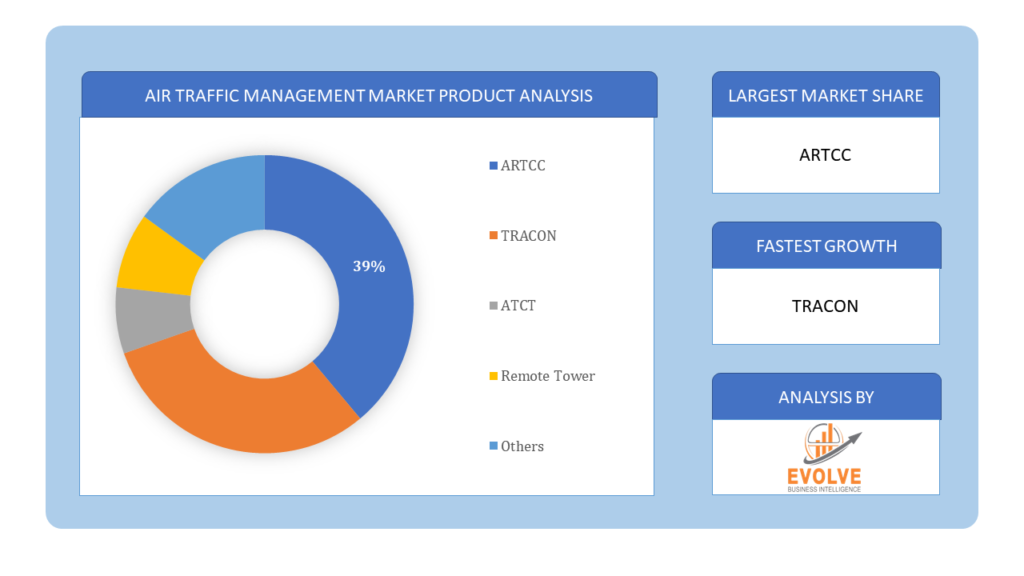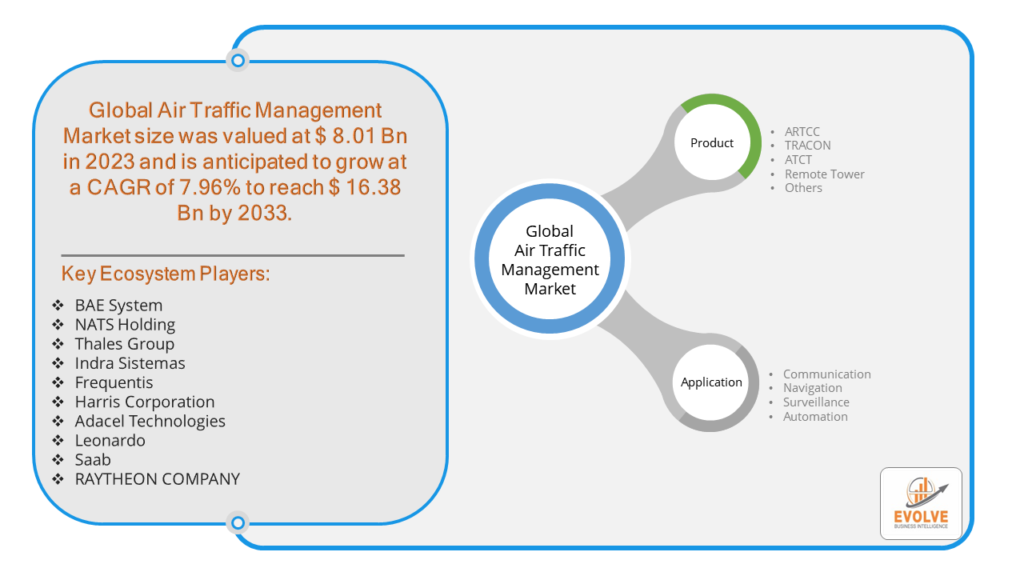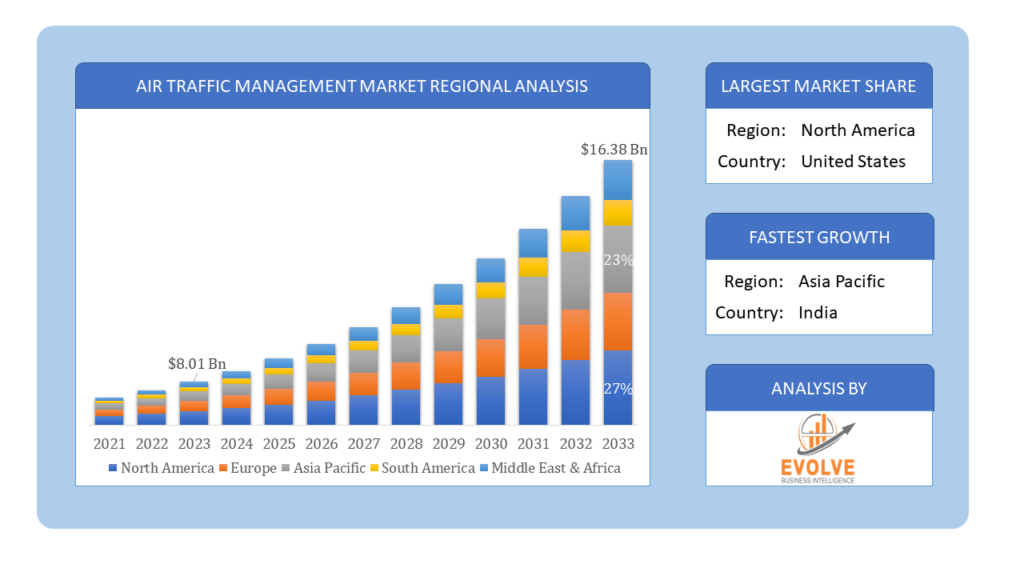Air Traffic Management Market Analysis and Global Forecast 2023-2033
$ 1,390.00 – $ 5,520.00Price range: $ 1,390.00 through $ 5,520.00
Air Traffic Management Market Research Report: Information By Airspace (ARTCC, TRACON, ATCT, Remote Tower), By Application (Communication, Navigation, Surveillance, Automation), and by Region — Forecast till 2033
Page: 172
Air Traffic Management Market Overview
The Air Traffic Management Market Size is expected to reach USD 16.38 Billion by 2033. The Air Traffic Management industry size accounted for USD 8.01 Billion in 2023 and is expected to expand at a compound annual growth rate (CAGR) of 7.96% from 2023 to 2033. The Air Traffic Management (ATM) market encompasses systems and services designed to ensure the safe and efficient movement of aircraft both on the ground and in the air. This includes air traffic control, airspace management, and flow management. Key components involve radar, communication, navigation, and surveillance systems. The market is driven by increasing air traffic, technological advancements, and the need for enhanced safety and efficiency. Major stakeholders include governments, airlines, and technology providers. Growth is further fueled by modernization programs and the implementation of next-generation ATM systems.
Global Air Traffic Management Market Synopsis
The COVID-19 pandemic has led to supply chain disruptions leading to supply shortages or lower demand in the air traffic control market. The travel restrictions and social-distancing measures have resulted in a sharp drop in consumer and business spending and this pattern is to continue for some time. The end-user trend and preferences have changed due to the pandemic and have resulted in manufacturers, developers, and service providers to adopt various strategies to stabilize the company.
Air Traffic Management Market Dynamics
The major factors that have impacted the growth of Air Traffic Management are as follows:
Drivers:
Ø Technological Advancements
Continuous innovations in technology, such as satellite-based navigation, automation, and artificial intelligence, are transforming ATM systems. These advancements enhance the precision, reliability, and efficiency of air traffic management, reducing delays and increasing capacity.
Restraint:
- Lack of Skilled Workforce
The operation and maintenance of advanced ATM systems require highly skilled personnel. There is a growing need for training and development programs to equip professionals with the necessary expertise, and a shortage of such skilled workers can impede market growth.
Opportunity:
⮚ Next-Generation ATM Systems
The development and implementation of next-generation ATM systems, such as SESAR in Europe and NextGen in the U.S., offer significant growth opportunities. These systems aim to enhance air traffic management through improved communication, navigation, and surveillance technologies, leading to increased capacity, efficiency, and safety.
Air Traffic Management Segment Overview
By Airspace
 Based on Airspace, the market is segmented based on ARTCC, TRACON, ATCT, Remote Tower. ARTCC dominates due to its critical role in managing en-route air traffic across extensive areas, ensuring the safe and efficient movement of aircraft between airports.
Based on Airspace, the market is segmented based on ARTCC, TRACON, ATCT, Remote Tower. ARTCC dominates due to its critical role in managing en-route air traffic across extensive areas, ensuring the safe and efficient movement of aircraft between airports.
By Application
Based on Applications, the market has been divided into the Communication, Navigation, Surveillance, Automation. The Air Traffic Management (ATM) market, segmented by applications, includes Communication, Navigation, Surveillance, and Automation. Among these, Automation dominates, driven by the increasing need for efficiency, safety, and real-time data processing to manage growing air traffic volumes.
Global Air Traffic Management Market Regional Analysis
Based on region, the global Air Traffic Management market has been divided into North America, Europe, Asia-Pacific, the Middle East & Africa, and Latin America. North America is projected to dominate the use of the Air Traffic Management market followed by the Asia-Pacific and Europe regions.
 Air Traffic Management North America Market
Air Traffic Management North America Market
North America holds a dominant position in the Air Traffic Management Market. Due to the strict air safety laws in well-known areas like the US and Canada, North America is now thought to be the greatest market. Asia Pacific is anticipated to develop at the highest rate, trailing only North America, because of the increased need for ATM systems for airport modernization. Over the course of the projection period, the other regions will even see consistent increase.
Air Traffic Management Asia-Pacific Market
The Asia-Pacific region has indeed emerged as the fastest-growing market for the Air Traffic Management industry. The Asia-Pacific air traffic management (ATM) market is experiencing significant growth due to the region’s rapid expansion in air travel and increasing passenger traffic. Key drivers include the modernization of air traffic control systems, implementation of advanced technologies like Automatic Dependent Surveillance-Broadcast (ADS-B), and government initiatives to enhance aviation infrastructure.
Competitive Landscape
The global Air Traffic Management market is highly competitive, with numerous players offering a wide range of software solutions. The competitive landscape is characterized by the presence of established companies, as well as emerging startups and niche players. To increase their market position and attract a wide consumer base, the businesses are employing various strategies, such as product launches, and strategic alliances.
Prominent Players:
- BAE System
- NATS Holding
- Thales Group
- Indra Sistemas
- Frequentis
- Harris Corporation
- Adacel Technologies
- Leonardo
- Saab
- RAYTHEON COMPANY
Key Development
In September 2022, BAE Systems announced significant advancements in air traffic management with the introduction of new technologies aimed at enhancing situational awareness and operational efficiency, contributing to safer and more effective airspace management globally.
Scope of the Report
Global Air Traffic Management Market, by Product
- ARTCC
- TRACON
- ATCT
- Remote Tower
- Others
Global Air Traffic Management Market, by Application
- Communication
- Navigation
- Surveillance
- Automation
Global Air Traffic Management Market, by Region
- North America
- US
- Canada
- Mexico
- Europe
- UK
- Germany
- France
- Italy
- Spain
- Benelux
- Nordic
- Rest of Europe
- Asia Pacific
- China
- Japan
- South Korea
- Indonesia
- Austalia
- Malaysia
- India
- Rest of Asia Pacific
- South America
- Brazil
- Argentina
- Rest of South America
- Middle East & Africa
- Saudi Arabia
- UAE
- Egypt
- South Africa
- Rest of Middle East & Africa
| Parameters | Indicators |
|---|---|
| Market Size | 2033: $16.38 Billion/strong> |
| CAGR | 7.96% CAGR (2023-2033) |
| Base year | 2022 |
| Forecast Period | 2023-2033 |
| Historical Data | 2021 |
| Report Coverage | Revenue Forecast, Competitive Landscape, Growth Factors, and Trends |
| Key Segmentations | Airspace, Application |
| Geographies Covered | North America, Europe, Asia-Pacific, Latin America, Middle East, Africa |
| Key Vendors | BAE System, NATS Holding, Thales Group, Indra Sistemas, Frequentis, Harris Corporation, Adacel Technologies, Leonardo, Saab, RAYTHEON COMPANY |
| Key Market Opportunities | • The valuable service for the aviation sectors |
| Key Market Drivers | • The need for air traffic management is increasing in the number of unmanned aerial vehicles |
REPORT CONTENT BRIEF:
- High-level analysis of the current and future Air Traffic Management market trends and opportunities
- Detailed analysis of current market drivers, restraining factors, and opportunities in the future
- Air Traffic Management market historical market size for the year 2021, and forecast from 2023 to 2033
- Air Traffic Management market share analysis at each product level
- Competitor analysis with detailed insight into its product segment, Government & Defense strength, and strategies adopted.
- Identifies key strategies adopted including product launches and developments, mergers and acquisitions, joint ventures, collaborations, and partnerships as well as funding taken and investment done, among others.
- To identify and understand the various factors involved in the global Air Traffic Management market affected by the pandemic
To provide a detailed insight into the major companies operating in the market. The profiling will include the Government & Defense health of the company’s past 2-3 years with segmental and regional revenue breakup, product offering, recent developments, SWOT analysis, and key strategies.
Press Release

Global Pharmaceutical Manufacturing Market to Reach $1.38 Trillion by 2035 with 7.35% CAGR, New Research Shows

The Global Mammography Market Is Estimated To Record a CAGR of Around 10.29% During The Forecast Period

Glue Stick Market to Reach USD 2.35 Billion by 2034

Podiatry Service Market to Reach USD 11.88 Billion by 2034

Microfluidics Technology Market to Reach USD 32.58 Billion by 2034

Ferric Chloride Market to Reach USD 10.65 Billion by 2034

Family Practice EMR Software Market to Reach USD 21.52 Billion by 2034

Electric Hairbrush Market to Reach USD 15.95 Billion by 2034

Daily Bamboo Products Market to Reach USD 143.52 Billion by 2034

Cross-border E-commerce Logistics Market to Reach USD 112.65 Billion by 2034
Frequently Asked Questions (FAQ)
1.What is the study period of this market?
- The study period of the global Air Traffic Management market is 2021- 2033
2.What is the growth rate of the global Air Traffic Management market?
- The global Air Traffic Management market is growing at a CAGR of 7.96% over the next 10 years
3.Which region has the highest growth rate in the market of Frozen Food?
- Asia Pacific is expected to register the highest CAGR during 2023-2033
4.Which region has the largest share of the global Air Traffic Management market?
- North America holds the largest share in 2022
5.Who are the key players in the global Air Traffic Management market?
BAE System, NATS Holding, Thales Group, Indra Sistemas, Frequentis, Harris Corporation, Adacel Technologies, Leonardo, Saab, and RAYTHEON COMPANY are the major companies operating in the market
Table of Content
Chapter 1. Executive Summary Chapter 2. Scope Of The Study 2.1. Market Definition 2.2. Scope Of The Study 2.2.1. Objectives of Report 2.2.2. Limitations 2.3. Market Structure Chapter 3. Evolve BI Methodology Chapter 4. Market Insights and Trends 4.1. Supply/ Value Chain Analysis 4.1.1. Raw Applications Providers 4.1.2. Manufacturing Process 4.1.3. Distributors/Retailers 4.1.4. End-Use Industry 4.2. Porter’s Five Forces Analysis 4.2.1. Threat Of New Entrants 4.2.2. Bargaining Power Of Buyers 4.2.3. Bargaining Power Of Suppliers 4.2.4. Threat Of Substitutes 4.2.5. Industry Rivalry 4.3. Impact Of COVID-19 on the Air Traffic Management Market 4.3.1. Impact on Market Size 4.3.2. End-Use Industry Trend, Preferences, and Budget Impact 4.3.3. Regulatory Framework/Government Policies 4.3.4. Key Players' Strategy to Tackle Negative Impact 4.3.5. Opportunity Window 4.4. Technology Overview 12.28. Macro factor 4.6. Micro Factor 4.7. Demand Supply Gap Analysis of the Air Traffic Management Market 4.8. Import Analysis of the Air Traffic Management Market 4.9. Export Analysis of the Air Traffic Management Market Chapter 5. Market Dynamics 5.1. Introduction 5.2. DROC Analysis 5.2.1. Drivers 5.2.2. Restraints 5.2.3. Opportunities 5.2.4. Challenges 5.3. Patent Analysis 5.4. Industry Roadmap 5.5. Parent/Peer Market Analysis Chapter 6. Global Air Traffic Management Market, By Airspace 6.1. Introduction 6.2. ARTCC 6.3. TRACON 6.4. ATCT 6.5. Remote Tower 6.6. Others Chapter 7. Global Air Traffic Management Market, By Application 7.1. Introduction 7.2. Communication 7.3. Navigation 7.4. Surveillance 7.5. Automation Chapter 8. Global Air Traffic Management Market, By Region 8.1. Introduction 8.2. North America 8.2.1. Introduction 8.2.2. Driving Factors, Opportunity Analyzed, and Key Trends 8.2.3. Market Size and Forecast, By Country, 2023-2033 8.2.4. Market Size and Forecast, By Airspace, 2023-2033 8.2.5. Market Size and Forecast, By Application, 2023-2033 8.2.6. US 8.2.6.1. Introduction 8.2.6.2. Driving Factors, Opportunity Analyzed, and Key Trends 8.2.6.3. Market Size and Forecast, By Airspace, 2023-2033 8.2.6.4. Market Size and Forecast, By Application, 2023-2033 8.2.7. Canada 8.2.7.1. Introduction 8.2.7.2. Driving Factors, Opportunity Analyzed, and Key Trends 8.2.7.4. Market Size and Forecast, By Airspace, 2023-2033 8.2.7.5. Market Size and Forecast, By Application, 2023-2033 8.3. Europe 8.3.1. Introduction 8.3.2. Driving Factors, Opportunity Analyzed, and Key Trends 8.3.3. Market Size and Forecast, By Country, 2023-2033 8.3.4. Market Size and Forecast, By Airspace, 2023-2033 8.3.5. Market Size and Forecast, By Application, 2023-2033 8.3.6. Germany 8.3.6.1. Introduction 8.3.6.2. Driving Factors, Opportunity Analyzed, and Key Trends 8.3.6.3. Market Size and Forecast, By Airspace, 2023-2033 8.3.6.4. Market Size and Forecast, By Application, 2023-2033 8.3.7. France 8.3.7.1. Introduction 8.3.7.2. Driving Factors, Opportunity Analyzed, and Key Trends 8.3.7.3. Market Size and Forecast, By Airspace, 2023-2033 8.3.7.4. Market Size and Forecast, By Application, 2023-2033 8.3.8. UK 8.3.8.1. Introduction 8.3.8.2. Driving Factors, Opportunity Analyzed, and Key Trends 8.3.8.3. Market Size and Forecast, By Airspace, 2023-2033 8.3.8.4. Market Size and Forecast, By Application, 2023-2033 8.3.9. Italy 8.3.9.1. Introduction 8.3.9.2. Driving Factors, Opportunity Analyzed, and Key Trends 8.3.9.3. Market Size and Forecast, By Airspace, 2023-2033 8.3.9.4. Market Size and Forecast, By Application, 2023-2033 8.3.11. Rest Of Europe 8.3.11.1. Introduction 8.3.11.2. Driving Factors, Opportunity Analyzed, and Key Trends 8.3.11.3. Market Size and Forecast, By Airspace, 2023-2033 8.3.11.4. Market Size and Forecast, By Application, 2023-2033 8.4. Asia-Pacific 8.4.1. Introduction 8.4.2. Driving Factors, Opportunity Analyzed, and Key Trends 8.4.3. Market Size and Forecast, By Country, 2023-2033 8.4.4. Market Size and Forecast, By Airspace, 2023-2033 8.12.28. Market Size and Forecast, By Application, 2023-2033 8.4.6. China 8.4.6.1. Introduction 8.4.6.2. Driving Factors, Opportunity Analyzed, and Key Trends 8.4.6.3. Market Size and Forecast, By Airspace, 2023-2033 8.4.6.4. Market Size and Forecast, By Application, 2023-2033 8.4.7. India 8.4.7.1. Introduction 8.4.7.2. Driving Factors, Opportunity Analyzed, and Key Trends 8.4.7.3. Market Size and Forecast, By Airspace, 2023-2033 8.4.7.4. Market Size and Forecast, By Application, 2023-2033 8.4.8. Japan 8.4.8.1. Introduction 8.4.8.2. Driving Factors, Opportunity Analyzed, and Key Trends 8.4.8.3. Market Size and Forecast, By Airspace, 2023-2033 8.4.8.4. Market Size and Forecast, By Application, 2023-2033 8.4.9. South Korea 8.4.9.1. Introduction 8.4.9.2. Driving Factors, Opportunity Analyzed, and Key Trends 8.4.9.3. Market Size and Forecast, By Airspace, 2023-2033 8.4.9.4. Market Size and Forecast, By Application, 2023-2033 8.4.10. Rest Of Asia-Pacific 8.4.10.1. Introduction 8.4.10.2. Driving Factors, Opportunity Analyzed, and Key Trends 8.4.10.3. Market Size and Forecast, By Airspace, 2023-2033 8.4.10.4. Market Size and Forecast, By Application, 2023-2033 8.5. Rest Of The World (RoW) 8.5.1. Introduction 8.5.2. Driving Factors, Opportunity Analyzed, and Key Trends 8.5.3. Market Size and Forecast, By Airspace, 2023-2033 8.5.4. Market Size and Forecast, By Application, 2023-2033 Chapter 9. Company Landscape 9.1. Introduction 9.2. Vendor Share Analysis 9.3. Key Development Analysis 9.4. Competitor Dashboard Chapter 10. Company Profiles 10.1. BAE System 10.1.1. Business Overview 10.1.2. Government & Defense Analysis 10.1.2.1. Government & Defense – Existing/Funding 10.1.3. Product Portfolio 10.1.4. Recent Development and Strategies Adopted 10.1.5. SWOT Analysis 10.2. NATS Holding 10.2.1. Business Overview 10.2.2. Government & Defense Analysis 10.2.2.1. Government & Defense – Existing/Funding 10.2.3. Product Portfolio 10.2.4. Recent Development and Strategies Adopted 10.2.5. SWOT Analysis 10.3. Thales Group 10.3.1. Business Overview 10.3.2. Government & Defense Analysis 10.3.2.1. Government & Defense – Existing/Funding 10.3.3. Product Portfolio 10.3.4. Recent Development and Strategies Adopted 10.3.5. SWOT Analysis 10.4. Indra Sistemas 10.4.1. Business Overview 10.4.2. Government & Defense Analysis 10.4.2.1. Government & Defense – Existing/Funding 10.4.3. Product Portfolio 10.4.4. Recent Development and Strategies Adopted 10.12.28. SWOT Analysis 10.5. Frequentis 10.5.1. Business Overview 10.5.2. Government & Defense Analysis 10.5.2.1. Government & Defense – Existing/Funding 10.5.3. Product Portfolio 10.5.4. Recent Development and Strategies Adopted 10.5.5. SWOT Analysis 10.6. Harris Corporation 10.6.1. Business Overview 10.6.2. Government & Defense Analysis 10.6.2.1. Government & Defense – Existing/Funding 10.6.3. Product Portfolio 10.6.4. Recent Development and Strategies Adopted 10.6.5. SWOT Analysis 10.7. Adacel Technologies 10.7.1. Business Overview 10.7.2. Government & Defense Analysis 10.7.2.1. Government & Defense – Existing/Funding 10.7.3. Product Portfolio 10.7.4. Recent Development and Strategies Adopted 10.7.5. SWOT Analysis 10.8 Leonardo 10.8.1. Business Overview 10.8.2. Government & Defense Analysis 10.8.2.1. Government & Defense – Existing/Funding 10.8.3. Product Portfolio 10.8.4. Recent Development and Strategies Adopted 10.8.5. SWOT Analysis 10.9 Saab 10.9.1. Business Overview 10.9.2. Government & Defense Analysis 10.9.2.1. Government & Defense – Existing/Funding 10.9.3. Product Portfolio 10.9.4. Recent Development and Strategies Adopted 10.9.5. SWOT Analysis 10.10. RAYTHEON COMPANY 10.10.1. Business Overview 10.10.2. Government & Defense Analysis 10.10.2.1. Government & Defense – Existing/Funding 10.10.3. Product Portfolio 10.10.4. Recent Development and Strategies Adopted 10.10.5. SWOT Analysis
Connect to Analyst
Research Methodology






